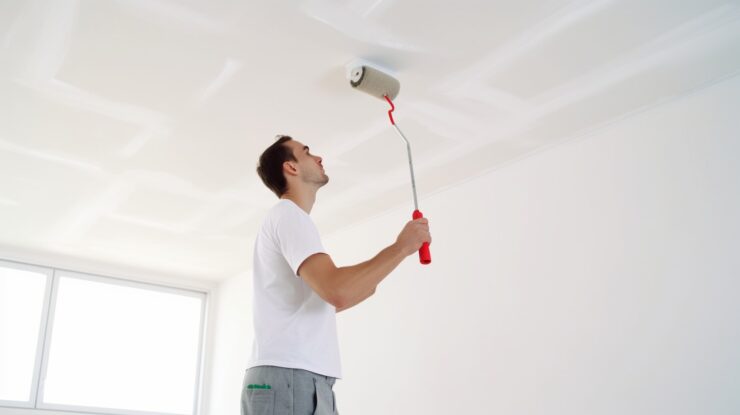When selecting a home’s design, we pay attention to even the smallest details. From room layouts to wall colors and choosing from various ceiling textures, we aim for perfection. The right choice for each room is essential and significant.
Ceiling textures refer to the design or pattern on the overhead surface that enhances its appearance. This article presents several ceiling texture types. To pick the ideal design or pattern for your room, it’s crucial to consider the room’s characteristics and make a choice based on that.
Ceiling Texture Types
If you’re in the process of renovating your home or moving into a new one and considering texturing your ceiling, we’ve got you covered. Unsure about the best ceiling texture for your space? Dive deep into this article for clarity.
By the end, you’ll have a clearer understanding of which texture suits your needs. Additionally, the options below can also serve as design inspirations for your walls.
1. Sheetrock Ceiling Texture
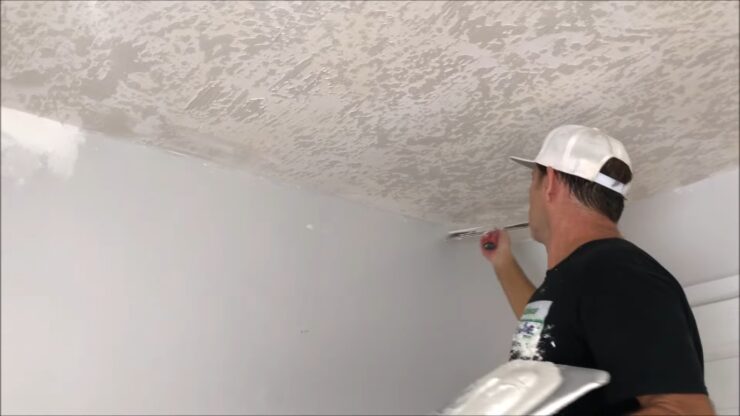
This texture has a tactile roughness. Instead of a smooth finish, it boasts a coarse surface. The unique artistic appearance is achieved more by the dexterity of the artisans than by brushes. Let’s weigh the advantages and disadvantages of this texture:
Best For: Modern homes and spaces that want a contemporary touch without being overly ornate.
Insights: Sheetrock texture is all about the artisan’s skill. It’s a testament to craftsmanship, where the hand’s touch is more important than tools. This texture works best in well-lit rooms where the play of light and shadow can accentuate its roughness.
| Pros | Cons |
|---|---|
| Gives a contemporary appeal to the room | Handcrafted, hence time-consuming |
| Remains timeless in design | Potential for minor surface imperfections |
| Ideal for rooms with diverse lighting options | Necessitates expert installation |
| Features exquisite hand-tooled finishes | Installation can be expensive |
2. Popcorn Ceiling Texture
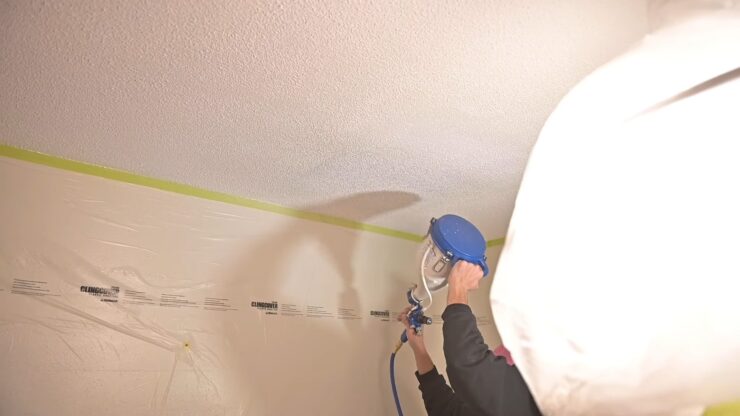
Often seen in many homes, the popcorn ceiling texture resembles the appearance of cottage cheese, giving it a bubbly surface. It’s especially favored in areas that benefit from enhanced brightness, such as hallways.
Best For: Older homes needing a quick makeover or spaces like hallways that benefit from a brighter ambiance.
Insights: Popcorn texture is a classic choice for many homeowners due to its cost-effectiveness and ability to hide imperfections. However, its bubbly appearance might not appeal to everyone, especially those aiming for a sleek modern look.
| Pros | Cons |
|---|---|
| Effectively conceals imperfections | Not suitable for every room |
| More cost-effective than other textures | Challenging to clean |
| Helps in sound absorption | Repairs can be intricate |
| Simple to apply | Maintenance can be demanding |
3. Crows Foot Ceiling Texture
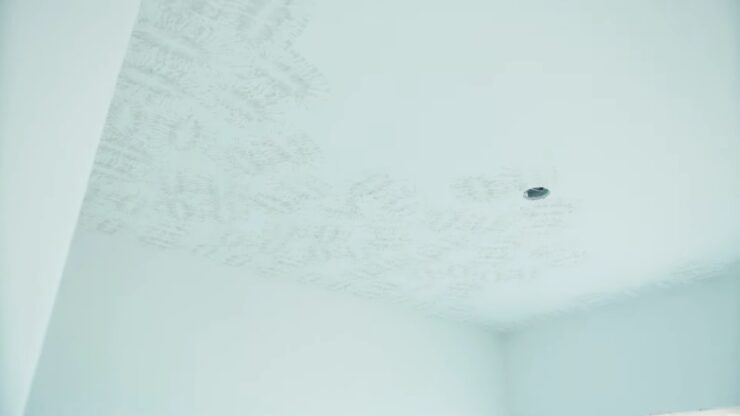
For those looking to add a unique touch to their ceilings, the Crows Foot texture, also known as the stomped pattern, is an excellent choice. It’s particularly adept at masking minor cracks. This texture requires a certain level of expertise and is best applied with a stipple brush.
If you’re considering a DIY approach, it’s advisable to practice first. The application process typically involves two individuals, as the pattern needs simultaneous dusting with mud. Ensure to cover the floors to minimize mess.
Best For: Creative spaces or rooms where a unique touch is desired without being too extravagant.
Insights: The Crows Foot texture is all about creativity. It’s not just a texture; it’s a piece of art on your ceiling. However, its application can be a bit messy, so preparation is key.
| Pros | Cons |
|---|---|
| Effectively hides minor cracks | Application can be messy due to mud |
| Distinctive design | Needs additional hands on deck |
| Eliminates the need for painting | DIY requires a certain skill level |
| Adds a modern flair to the room | More intricate than other textures |
4. Spray Sand Ceiling Texture
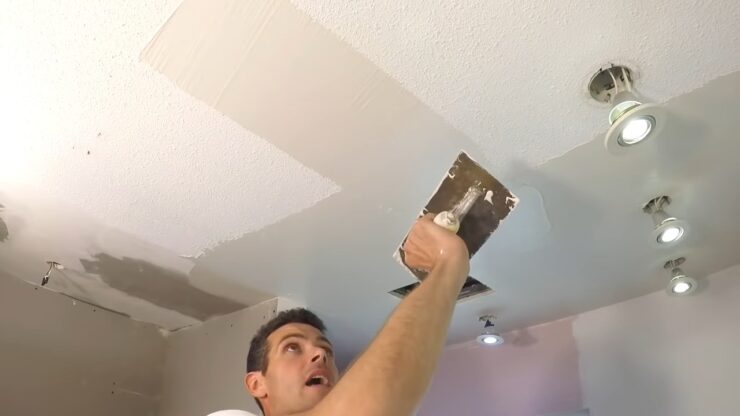
True to its name, this texture involves a mixture of sand with water or primer, which is then sprayed onto the ceiling or wall using a hopper gun. While it’s more commonly preferred for ceilings, some opt to use it on walls as well. For added aesthetics, a touch of paint can be incorporated.
Best For: Spaces that want a subtle texture without the heaviness of more traditional styles.
Insights: The beauty of the spray sand texture lies in its simplicity. It’s a nod to minimalism, where less is more. The addition of paint can elevate its appearance, making it versatile.
| Pros | Cons |
|---|---|
| Application is straightforward | Incorrect spraying can disrupt texture |
| Cost-effective stylish ceiling solution | Might not cover corners effectively |
| Paint can elevate its visual appeal | Requires a specific gun for spraying |
| Time-efficient process | Expertise needed for neat application |
5. Drywall Ceiling Texture
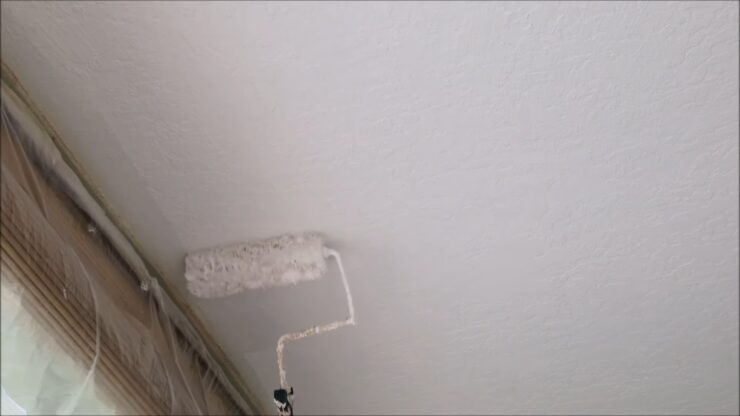
The term “drywall ceiling texture” is broad and versatile, allowing for a range of textural designs. Many popular ceiling textures, such as popcorn, orange peel, knockdown, swirl, and slap brush, fall under the drywall category.
Best For: Those who want flexibility in their ceiling design. It’s a blank canvas waiting for your touch.
Insights: Drywall texture is the jack-of-all-trades in the ceiling world. Its adaptability means it can fit into any home, from the ultra-modern to the vintage.
| Pros | Cons |
|---|---|
| Offers flexibility in texture choices | Challenging to remove |
| Allows for diverse color combinations | Can sometimes appear outdated |
| Serves as an effective camouflage | Dusting can be cumbersome |
6. Orange Peel Drywall Texture
The orange peel texture, as the name suggests, mimics the bumpy and refreshing surface of an orange. This intriguing texture is ideal for rooms that don’t necessitate regular cleaning. Its availability in spray form simplifies the application process.
Best For: Rooms that want a refreshing and lively touch, like living rooms or recreational spaces.
Insights: The orange peel texture is all about vibrancy. It’s a texture that adds life to a room. Its bumpy appearance can be a conversation starter, making it perfect for social spaces.
| Pros | Cons |
|---|---|
| Enhances room’s acoustics by controlling sound | Cleaning tiny gaps in the pattern is tough |
| Imparts a gentle and airy ambiance to the room | Might be too commonplace |
| Visually appealing | |
| DIY-friendly with the availability of sprays |
7. Comb Drywall Texture
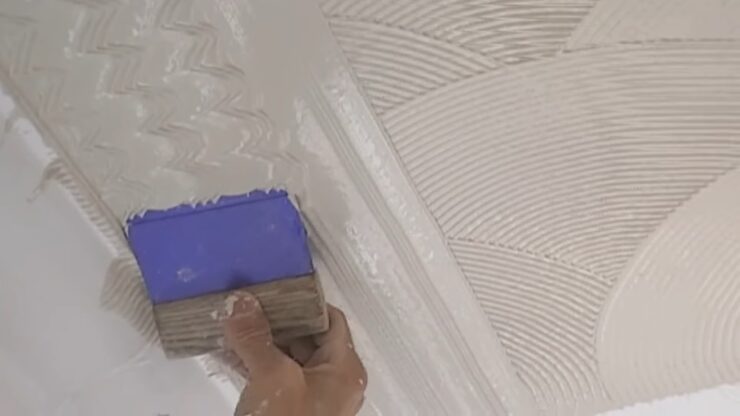
The comb drywall texture is crafted using a toothed trowel to produce a series of grooves on the ceiling. This texture style is ideal for transforming plain ceilings into visually appealing surfaces. Its simplicity lies in the use of lines of varying widths to achieve the desired pattern, whether on the ceiling or wall.
Best For: Formal settings or spaces that want a touch of sophistication without being too ornate.
Insights: The comb texture is elegance personified. Its orderly patterns exude a sense of sophistication, making it perfect for dining rooms or corporate settings.
| Pros | Cons |
|---|---|
| Imparts a sophisticated appearance | Precision is crucial for pattern creation |
| Can be handcrafted | Maintaining design symmetry can be challenging |
| Offers versatility with rainbow or fan patterns | Expertise is essential for consistent results |
8. Skip Trowel Ceiling Texture
The skip trowel texture stands out due to its distinctive random patterns. The application involves spreading a joint compound on the ceiling or wall and maneuvering the trowel in any desired direction. A well-executed skip trowel texture will have sections that are smooth and untouched.
Best For: Spaces that want a rustic touch. It’s all about celebrating imperfections.
Insights: The skip trowel texture is for those who believe that beauty lies in imperfections. Its random patterns mean that no two ceilings will be the same, giving each room its unique touch.
| Pros | Cons |
|---|---|
| Patterns are straightforward to create | Once the plaster dries, adjustments are challenging |
| Can be tailored to be subtle or bold | Some view it as a less refined technique |
| Imperfections can enhance the overall design |
9. Lace Ceiling Texture
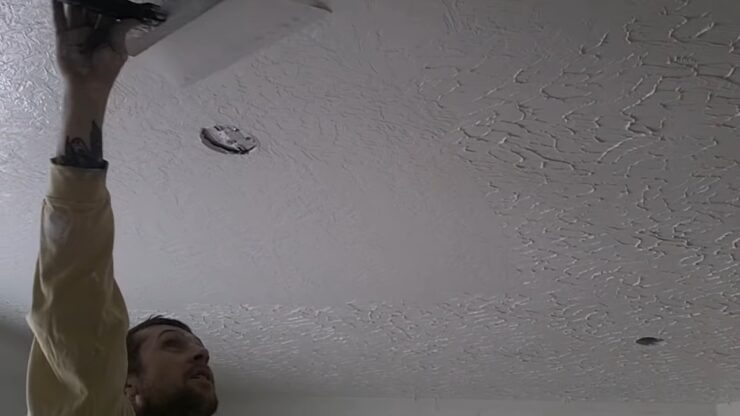
The lace texture is a showstopper, designed to captivate and draw attention. Among ceiling textures, it’s one of the most intricate and visually stunning. Achieving the final look requires a combination of tools, expertise, and patience. The design involves layering one color over another, resulting in a harmonious blend.
Best For: Grand spaces that aim to impress. Think ballrooms or large dining areas.
Insights: The lace texture is all about opulence. It’s a texture that demands attention and is sure to impress guests. However, its intricate design means it’s best left to the professionals.
| Pros | Cons |
|---|---|
| Exudes an artistic and eye-catching appearance | Time-intensive and requires effort |
| Offers a variety of pattern options | Best executed by professionals |
| Dual-tone design adds depth and uniqueness | Color selection is crucial for the desired effect |
10. Swirl Ceiling Texture
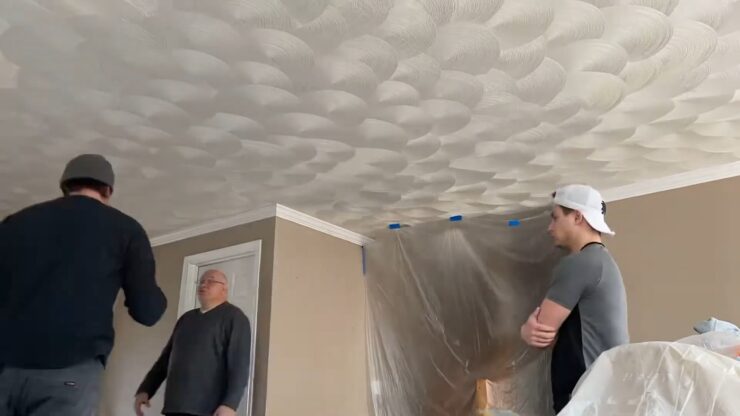
For those who appreciate circular designs, the swirl ceiling texture is a popular choice. Commonly found in many homes, its application method is akin to the skip trowel, but with a focus on creating consistent circular patterns. The tool used plays a pivotal role in determining the precision and diameter of the swirls.
Best For: Homes that want a classic touch. It’s a nod to tradition.
Insights: The swirl texture is timeless. Its circular patterns have a certain charm that never goes out of style. It’s perfect for those who want a touch of nostalgia in their homes.
| Pros | Cons |
|---|---|
| Relatively simple to apply to ceilings | The repetitive pattern can be mesmerizing |
| Minimal tools needed | Precision hinges on the artisan’s hand movement |
| Highly customizable to fit personal preferences |
11. Hawk And Trowel Ceiling Texture
The hawk and trowel texture is achieved using its namesake tools. This design features layers of drywall mud that overlap, creating a wavy, water-like appearance. The final look can vary based on the thickness of the material used, leading to multiple variations of this texture.
Best For: Spaces that want a touch of the outdoors. It’s nature brought indoors.
Insights: The hawk and trowel texture is reminiscent of flowing water. It’s perfect for those who want to bring a touch of nature into their homes.
| Pros | Cons |
|---|---|
| Transforms plain walls into dynamic surfaces | Thicker applications may peel over time |
| Doesn’t demand high expertise for application | Might not be as visually striking as other textures |
| Unique techniques can elevate its visual appeal | Regular upkeep is necessary for its longevity |
12. Slap Brush Ceiling Texture
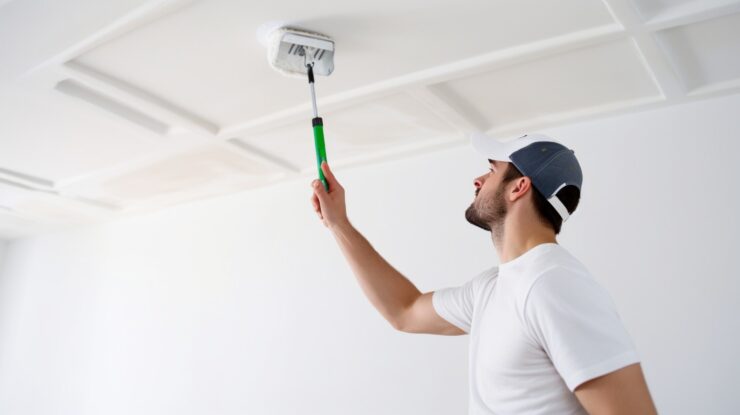
The slap brush texture, as the name suggests, is achieved by “slapping” a brush with stiff bristles onto the ceiling. After applying a thin layer of compound and mud, the brush is slapped at an angle, resulting in spontaneous patterns. The outcome can be quite captivating if executed correctly.
Best For: Creative spaces or children’s rooms. It’s all about fun and spontaneity.
Insights: The slap brush texture is playful. Its random patterns can add a touch of whimsy to any room, making it perfect for spaces that want to let loose.
| Pros | Cons |
|---|---|
| Widely favored in many homes | There’s a risk of it not turning out as expected |
| The brush’s long handle offers better control | Applying on ceilings can be challenging |
| Gentle touches yield a delicate texture |
13. Rosebud Ceiling Texture
The rosebud texture is a delightful choice for those looking to infuse a touch of floral elegance into their living spaces. This design features a pattern reminiscent of rose petals, making it especially suitable for rooms with plain walls. While the rose design is popular, there’s flexibility to choose other floral patterns as well.
Best For: Bedrooms or boutique-style spaces. It’s a touch of romance.
Insights: The rosebud texture is all about romance. Its floral patterns can make any room feel cozy and inviting, making it perfect for intimate spaces.
| Pros | Cons |
|---|---|
| Floral patterns add a touch of elegance | Using thick mud can distort the design |
| Relatively simple to apply | Uneven mud application can lead to sharp edges |
| Offers the flexibility of various floral designs |
14. Tree Bark Ceiling Texture
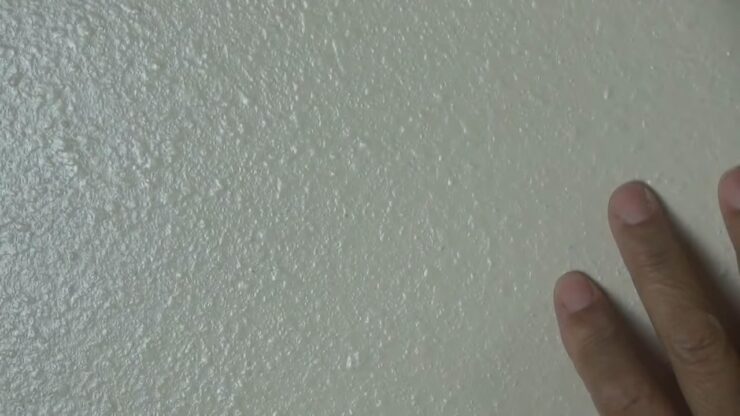
The tree bark texture, as the name suggests, mimics the rugged appearance of tree bark. This design is achieved using a roller, which creates a consistent pattern on a thinly mud-layered surface, resulting in a stylish finish.
Best For: Rustic homes or cabins. It’s a touch of the wilderness.
Insights: The tree bark texture brings the ruggedness of the outdoors inside. It’s perfect for homes that want a rustic touch.
| Pros | Cons |
|---|---|
| Roller application simplifies the process | A very thin mud layer might not be as effective |
| Effectively conceals old ceiling flaws | A thin layer can lead to design inconsistencies |
| Produces a refined and understated outcome |
15. Knockdown Ceiling Texture
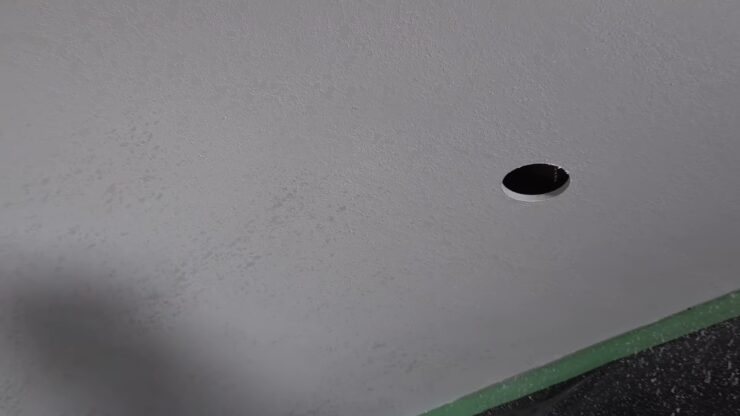
The knockdown texture is distinct in its application process. After applying the ceiling compound, it’s essential to let it settle before leveling it with a specialized tool. The subsequent step involves “knocking down” the texture using a sponge or brush. Once set, any imperfections at the edges can be corrected or painted over.
Best For: Modern homes that want a sleek yet textured appearance.
Insights: The knockdown texture is a modern classic. Its sleek appearance, combined with its textured feel, makes it perfect for contemporary homes.
| Pros | Cons |
|---|---|
| Offers a sought-after look | Installation can be challenging |
| Excellently masks ceiling imperfections | Repairs can be intricate |
| Adds a sense of depth and warmth to rooms | Patience is key during application |
16. Fish Scale Ceiling Texture
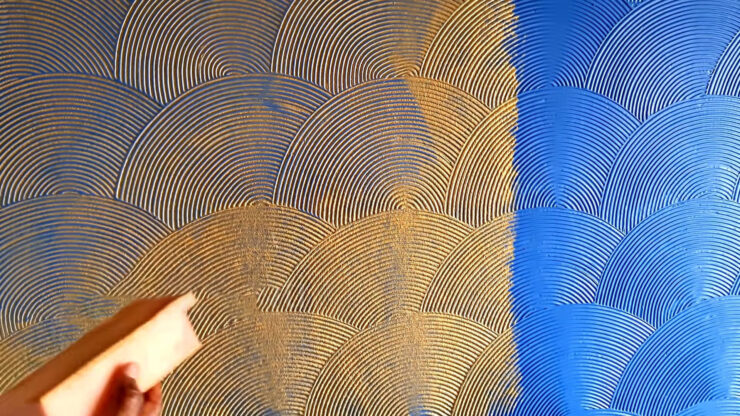
The fish scale texture, also known as the fan or shell pattern, features a series of half circles or arches, reminiscent of fish scales. This design is not only visually appealing but also unique, ensuring that homes with this texture stand out.
Best For: Spaces that want to stand out. It’s a statement piece.
Insights: The fish scale texture is all about making a statement. Its unique patterns ensure that any room it’s in becomes the center of attention.
| Pros | Cons |
|---|---|
| Provides a distinctive and captivating look | Application can be complex |
| Complements various wall designs seamlessly | Best results often require professional installation |
| Enhancing with paint accentuates the design | Any errors in application can be glaring |
17. Santa Fe Ceiling Texture
The Santa Fe texture is reminiscent of the skip trowel but covers a more extensive area. Typically, while the skip trowel might texture a smaller portion of the ceiling, the Santa Fe style covers about sixty percent. The application involves random motions at specific angles across the ceiling.
Best For: Homes aiming for a rustic or southwestern aesthetic.
Insights: The Santa Fe texture, with its more extensive coverage, offers a warm, earthy feel reminiscent of adobe homes. It’s perfect for those who want a touch of the American Southwest in their living spaces. When paired with terracotta or muted earth tones, it can truly shine.
| Pros | Cons |
|---|---|
| The irregular texture is aesthetically pleasing | Often mistaken for skip trowel |
| Simple to create random patterns | Not a top choice for many |
| Features more smooth sections |
18. Mud And Tape Ceiling Texture
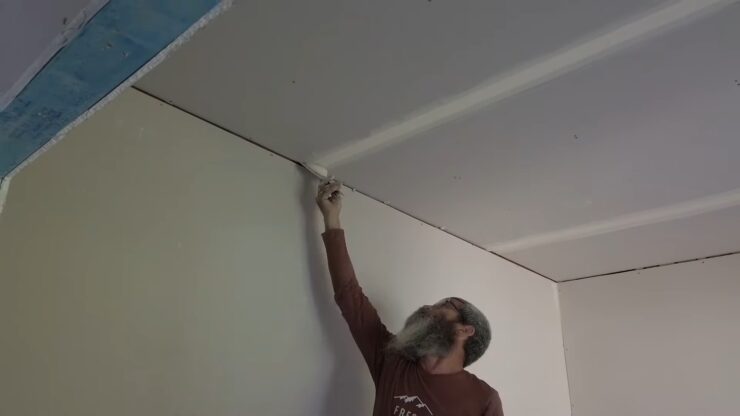
This is perhaps one of the most prevalent ceiling textures. It revitalizes a plain ceiling, adding depth and interest. The tape is used to cover joints, repaired sections, and corners, followed by a layer of mud splashed across the ceiling.
Best For: Renovations where there’s a need to cover up joints, repaired sections, and corners.
Insights: This texture is a go-to for many contractors during renovations. It’s not just about aesthetics; it’s also about functionality. The tape strengthens the joints, and the mud provides a seamless finish, making it ideal for older homes undergoing refurbishment.
| Pros | Cons |
|---|---|
| More expensive, but offers a refined look | Application of mud can be messy |
| Can rejuvenate a damaged ceiling | DIY might be challenging for those with dust allergies |
| Utilizes basic tools |
19. Stomp Ceiling Texture
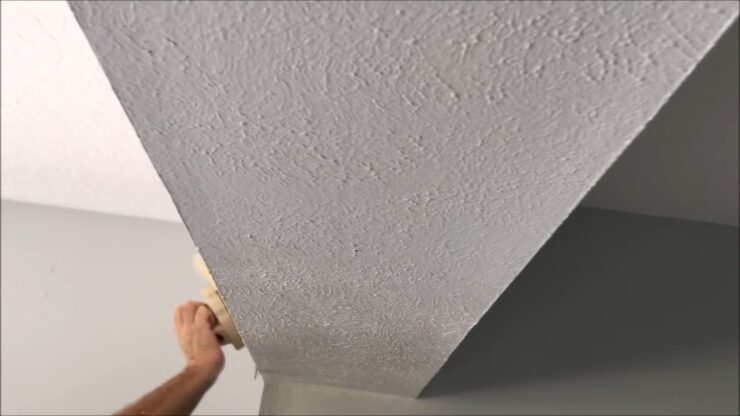
The stomp texture is perfect for those aiming to conceal ceiling flaws and stains. The key is to dilute the compound with water until it achieves a paint-like consistency. A stomp brush is then used to craft the patterns.
Best For: Older homes with a lot of ceiling imperfections or stains.
Insights: The stomp texture is a lifesaver for ceilings that have seen better days. Its ability to hide flaws means homeowners can avoid costly repairs. However, it’s essential to ensure the room is well-prepped to avoid any unintended mess.
| Pros | Cons |
|---|---|
| Masks ceiling imperfections effectively | Desired finish hinges on compound consistency |
| Patterns are straightforward to achieve | Potential to damage furniture during application |
| Doesn’t require specialized tools |
20. Light Popcorn Texture
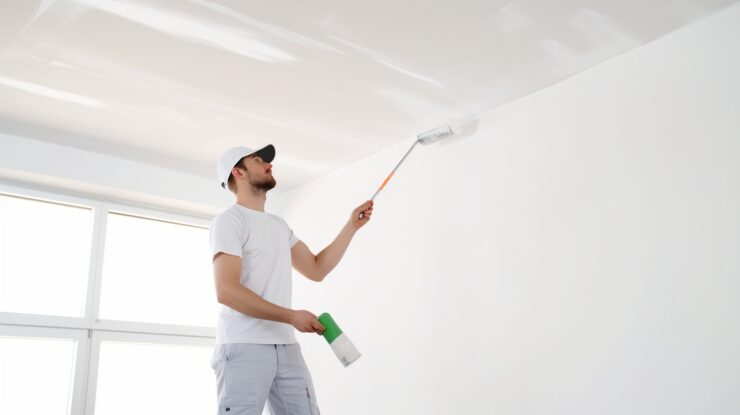
For individuals who appreciate adaptability in ceiling design, the light popcorn texture is ideal. It offers a less pronounced popcorn effect, allowing for easy repainting in various light hues. This texture is suitable for those who prefer subtlety over bold patterns.
| Pros | Cons |
|---|---|
| Offers a subdued, non-distracting appearance | Might be too plain for some |
| Exudes a refined charm | Without paint, the texture might lack prominence |
| Light hues complement white walls seamlessly | Might need periodic repainting to retain its allure |
Best For: Homeowners who prefer a minimalist approach but still want some texture.
Insights: The light popcorn texture is a toned-down version of the traditional popcorn ceiling. Its subtlety makes it perfect for modern homes where the emphasis is on clean lines and simplicity. Its adaptability in terms of paint means homeowners can easily switch up room aesthetics without a complete overhaul.
FAQs
What is the latest trend in ceiling finishes?
The latest trends in ceiling finishes lean towards a more modern and minimalist approach. Smooth ceilings, often painted in flat or matte finishes, are becoming increasingly popular. Additionally, architectural features like coffered ceilings, tray ceilings, and exposed beams are also in vogue.
What is the most expensive ceiling texture?
Lace and artisan handcrafted textures tend to be among the most expensive ceiling textures. These intricate designs require skilled professionals for application, leading to higher labor and material costs.
What type of ceiling is popular?
Smooth ceilings are currently popular, especially in modern and contemporary homes. They offer a clean and sleek appearance, making rooms feel more spacious and uncluttered. However, traditional textures like popcorn and knockdown remain common in many homes.
What type of finish is best for ceilings?
A flat or matte finish is often recommended for ceilings. This type of finish does not reflect light, helping to hide imperfections and giving the ceiling a smooth appearance.
Do modern ceilings have texture?
While many modern ceilings lean towards a smooth finish, some contemporary designs still incorporate texture for added depth and character. The choice often depends on the overall design aesthetic of the home and the homeowner’s personal preference.
Final Words
Choosing the right ceiling texture is an art that combines aesthetics with functionality. Whether you’re renovating an old space or designing a new one, the ceiling texture can significantly influence the room’s ambiance.
Moreover, ensuring that your home is safeguarded with the right home warranty can be just as crucial as selecting the perfect ceiling texture.
From the rustic charm of the tree bark texture to the modern elegance of the knockdown finish, there’s a texture to suit every preference and style. Remember, the ceiling is often referred to as the fifth wall of a room, so give it the attention it deserves. With the plethora of options available, you’re sure to find the perfect match for your home.

